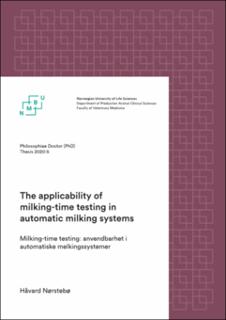| dc.contributor.advisor | Reksen, Olav | |
| dc.contributor.advisor | Nødtvedt, Ane | |
| dc.contributor.advisor | Whist, Anne Cathrine | |
| dc.contributor.author | Nørstebø, Håvard | |
| dc.coverage.spatial | Norway | en_US |
| dc.date.accessioned | 2020-08-05T10:13:58Z | |
| dc.date.available | 2020-08-05T10:13:58Z | |
| dc.date.issued | 2020 | |
| dc.identifier.isbn | 978-82-575-1661-1 | |
| dc.identifier.issn | 1894-6402 | |
| dc.identifier.uri | https://hdl.handle.net/11250/2670913 | |
| dc.description.abstract | Norsk mjølkeproduksjon forandrer seg i retning større produksjonsenheter, økende bruk av automatiske mjølkingssystemer (AMS) og reduserte økonomiske marginer. Til tross for at situasjonen har forbedret seg kraftig de siste to tiårene er mastitt fortsatt en utfordring i norsk mjølkeproduksjon. Det årlige tapet på grunn av mastitt er beregna til 120 millioner kroner. Mastitt er ikke bare viktig i et økonomisk perspektiv, men også fordi sjukdommen påvirker dyrevelferden og fordi det er den viktigste årsaken til bruk av antibiotika i mjølkekubesetninger. Dette gjør det viktig å forebygge mastitt for å opprettholde en effektiv og bærekraftig mjølkeproduksjon. De raske endringene i norsk mjølkeproduksjon med stadig økende bruk av AMS gjør det nødvendig med ny kunnskap for å forbedre jurhelsa. | en_US |
| dc.description.abstract | Norwegian dairy production is changing towards larger production units, increasing use of automatic milking systems (AMS), and decreasing economic margins. Bovine mastitis remains a challenge in Norwegian dairy production, with an estimated annual cost of 120 million Norwegian kroner. The disease is not only important from an economic perspective, but also because it affects the general health and wellbeing of the cow and because mastitis is the main reason for using antimicrobial drugs in dairy production. Preventing mastitis is therefore essential for maintaining efficient and sustainable production on Norwegian dairy farms, and there is a need for knowledge to improve udder health in an environment that is changing rapidly as the number of farms with AMS continues to grow in Norway. | en_US |
| dc.language.iso | eng | en_US |
| dc.publisher | Norwegian University of Life Sciences, Ås | en_US |
| dc.relation.ispartofseries | PhD Thesis;2020:5 | |
| dc.rights | Attribution-NonCommercial-NoDerivatives 4.0 Internasjonal | * |
| dc.rights | Attribution-NonCommercial-NoDerivatives 4.0 Internasjonal | * |
| dc.rights | Attribution-NonCommercial-NoDerivatives 4.0 Internasjonal | * |
| dc.rights.uri | http://creativecommons.org/licenses/by-nc-nd/4.0/deed.no | * |
| dc.subject | Mastitis | en_US |
| dc.subject | Intramammary infections | en_US |
| dc.subject | Somatic cell count | en_US |
| dc.subject | Dairy cattle | en_US |
| dc.subject | Cattle | en_US |
| dc.title | The applicability of milking-time testing in automatic milking systems | en_US |
| dc.title.alternative | Milking-time testing : anvendbarhet i automatiske melkingssystemer | en_US |
| dc.type | Doctoral thesis | en_US |
| dc.relation.project | Norges forskningsråd: 244213 | en_US |
| dc.relation.project | Norges forskningsråd: 249159 | en_US |

